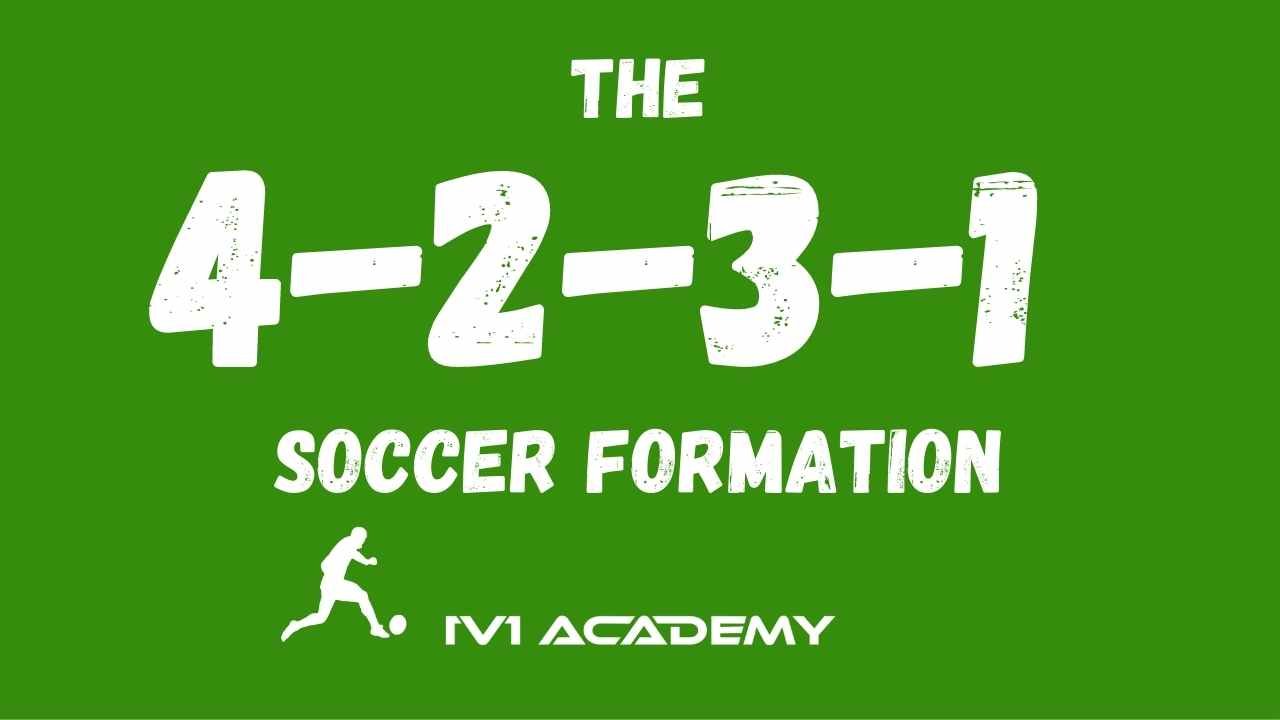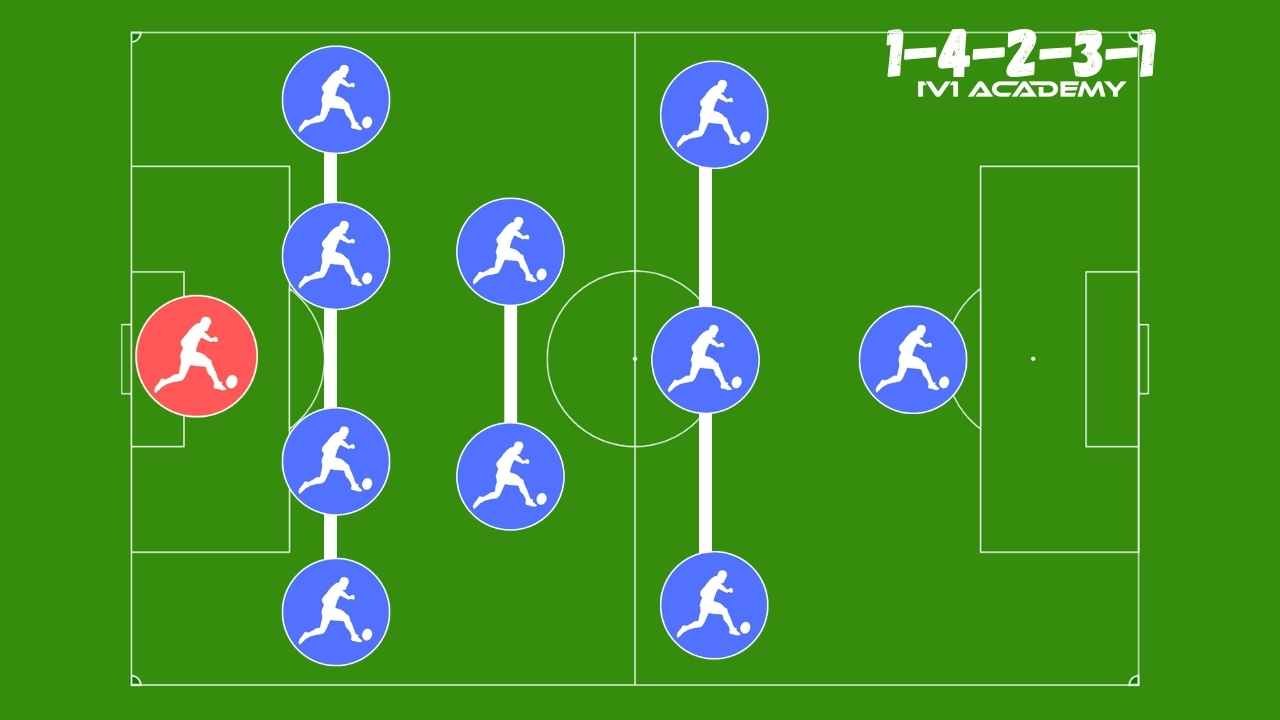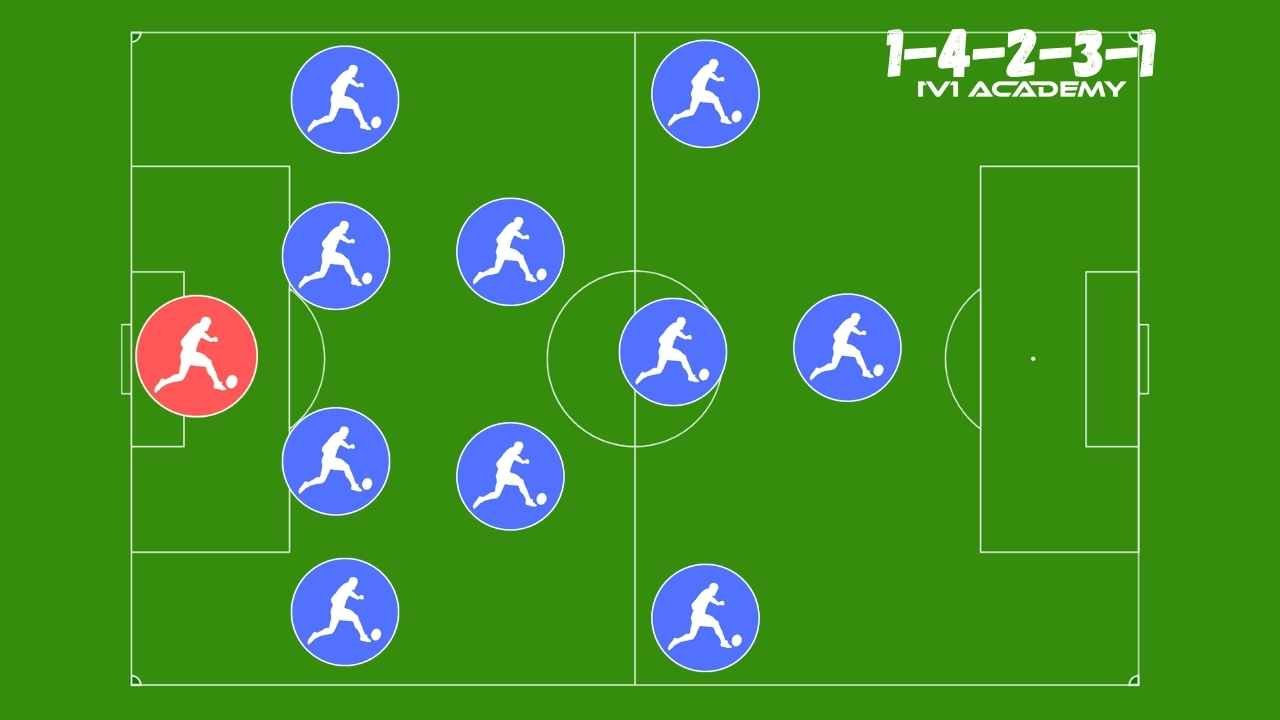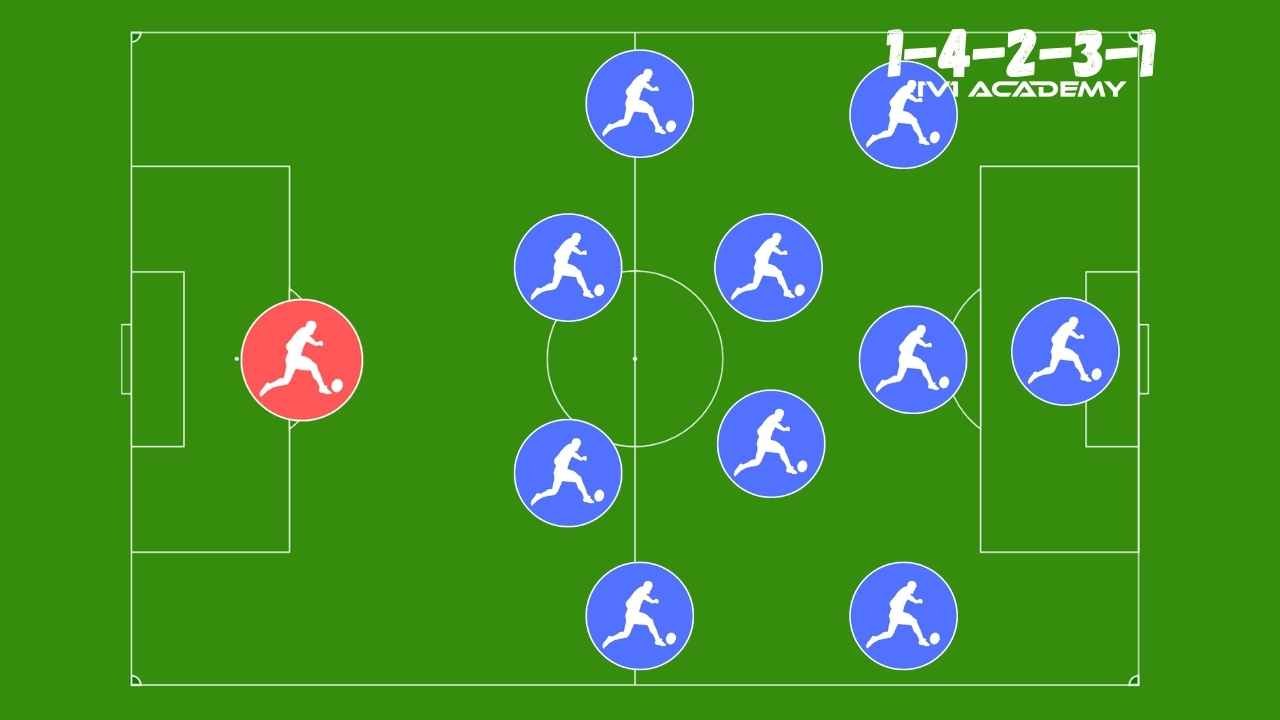
Play to listen to the article.
By Rudy Glez
1v1Academy. An Online Soccer Academy
Soccer Tactics: Mastering the 4-2-3-1 Formation for Optimal Performance.
If you’re a soccer coach or player, you’ve probably heard of the 4-2-3-1 formation. It’s one of the most popular systems of play in soccer, used by professional teams worldwide. But what is the 4-2-3-1 formation, and how does it work? We’ll take a deep dive into the 4-2-3-1 formation, exploring its strengths, weaknesses, and strategies for implementation.

What is the 4-2-3-1 Soccer Formation?
The 4-2-3-1 formation is a system of play used in soccer that features four defenders, two holding midfielders, three attacking midfielders, and one forward. The goalkeeper is positioned behind the four defenders and serves as the final line of defense. The two holding midfielders sit in front of the back four and protect the defense, while the three attacking midfielders play ahead of them and support the lone striker upfront.
How Does the 4-2-3-1 Soccer Formation Work?
The 4-2-3-1 formation is a balanced system of play that emphasizes possession and quick, attacking movements. It’s designed to provide defensive stability while also allowing the team to attack with speed and precision. The back four and holding midfielders provide a solid defensive base, while the attacking midfielders and lone forward create opportunities for goals.
The key to the 4-2-3-1 formation is the movement of the attacking midfielders. They are responsible for creating space and opportunities for the lone striker, who must be quick and clinical in front of the goal. The two holding midfielders must be disciplined and focused on protecting the defense, while the back four must be organized and able to handle the opposition’s attacking threats.
What Strategies Should I Use with the 4-2-3-1 Soccer Formation?
One of the main strategies for the 4-2-3-1 formation is to use the attacking midfielders to overload the opposition’s defense. This means the three attacking midfielders will often play in positions that draw the opposition’s defenders out of position, creating gaps that the lone striker can exploit. It’s also essential to have quick, skillful attacking midfielders who can dribble past defenders and create goal-scoring opportunities.
Defensively, the two holding midfielders must work together to protect the back four. They should be positioned to cover the gaps between the defenders and prevent the opposition from creating chances in front of goal. The back four must communicate effectively and stay organized to prevent the opposition from exploiting gaps in the defense.
How Can I Implement the 4-2-3-1 Soccer Formation with My Team?
Implementing the 4-2-3-1 formation requires careful planning and preparation. You’ll need to choose players suited to the different positions and ensure they understand their roles and responsibilities on the field. You’ll also need to work on specific training drills emphasizing the formation’s strengths, such as quick, attacking movements and defensive stability.
It’s important to be flexible when implementing the 4-2-3-1 formation. You may need to adjust the players’ positions depending on the strengths and weaknesses of your team and the opposition. You may also need to adjust the formation during the game to respond to opposition tactics changes.
The 4-2-3-1 formation is a popular and effective system of play in soccer. It provides a solid defensive base while also allowing the team to attack with speed and precision. By emphasizing possession and quick, attacking movements, the 4-2-3-1 formation can help your team achieve optimal performance on the field.

Why the 4-2-3-1 Formation Reigns Supreme in Soccer
As a soccer coach, you constantly search for the best formation to optimize your team’s performance. While there are many systems of play to choose from, the 4-2-3-1 formation stands out as the superior option. Here’s why:
Adaptability
Coaches and Soccer players often use the 4-2-3-1 formation because it is a versatile and flexible system of play. You can customize and fine-tune it according to the abilities and limitations of your players. For example, if you have quick and skillful attacking midfielders, you can push them up higher to support the lone striker and create more scoring opportunities. On the other hand, if your team lacks pace, you can drop your attacking midfielders back to protect the defense.
Defensive Stability
One of the main strengths of the 4-2-3-1 formation is its defensive stability. The two holding midfielders provide a solid shield in front of the back four, making it difficult for the opposition to create chances. This allows the defenders to focus on their defensive duties and prevent the opposition from scoring. The attacking midfielders can also drop back to support the defense when necessary.
Attacking Potential
While the 4-2-3-1 formation is known for its defensive stability, it’s also an attacking powerhouse. The three attacking midfielders constantly threaten the opposition’s defense, with their movement and passing ability creating space for the lone striker to exploit. The attacking midfielders can also support each other, making intricate passing movements that can open even the tightest defenses.
Midfield Control
In soccer, control of the midfield is crucial to winning games. With the 4-2-3-1 formation, you have two holding midfielders who can dominate the center of the park, winning possession and distributing the ball to the attacking midfielders. This allows your team to control the pace of the game and dictate the tempo.
Player Roles
The 4-2-3-1 formation is a player-friendly system of play. Each player has a clearly defined role and knows what’s expected of them. This makes it easier for players to focus on their individual duties and play as a unit. Additionally, the formation allows for a lot of creativity and individual creativity from the attacking midfielders, giving them the freedom to express themselves on the field.
Conclusion
The 4-2-3-1 formation is the superior system of play in soccer. Its adaptability, defensive stability, attacking potential, midfield control, and player-friendly roles make it the ideal choice for any team looking to optimize its performance. By implementing the 4-2-3-1 formation and adjusting it to fit the capabilities of your players, you can unleash your team’s potential and dominate on the field.

When to Use the 4-2-3-1 Soccer Formation According to Your Player’s Capabilities
When should you use this formation, and how do you adjust it based on your players’ abilities?
First and foremost, it’s essential to consider the strengths and weaknesses of your team. The 4-2-3-1 formation could be an excellent choice if you have a strong defense. The four defenders will provide a solid base to build from, and the two holding midfielders will give them additional support. This formation can also be effective against teams with strong attacking players, as it allows for quick counter-attacks through the three attacking midfielders and the lone forward.
If your team has a strong midfield, the 4-2-3-1 formation can also be beneficial. The three attacking midfielders can create and score goals, while the two holding midfielders provide a shield for the defense. This formation can also help control the midfield, which can be crucial to winning games.
On the other hand, if your team has a strong forward, it may be better to use a different formation. The 4-2-3-1 formation relies heavily on the lone striker to score goals, and if they are not up to the task, it can leave the team struggling to create chances. In this case, a 4-3-3 formation with two wingers supporting the forward may be a better option.
It’s also important to consider the skill level of your players. The 4-2-3-1 formation requires strong players in key positions, such as the two holding midfielders and the lone forward. If your team lacks the necessary skills for these positions, using a different formation that suits your players’ abilities may be better.
The 4-2-3-1 soccer formation can be a highly effective system of play when used correctly. As a coach, you must consider your team’s strengths and weaknesses and adjust the formation accordingly. Doing so can create a winning team that plays to its strengths and maximizes its potential.
When to Avoid Using the 4-2-3-1 Soccer Formation: Based on Your Team’s Capabilities
Here are some recommendations on when to avoid using this formation based on your players’ capabilities.
- Lack of Strong Central Midfielders: The 4-2-3-1 formation relies heavily on the central midfielders to control the game and distribute the ball to the attacking players. If your team lacks strong central midfielders, maintaining possession and creating scoring opportunities may be difficult. It may be better to use a formation with less emphasis on the midfield, such as a 4-4-2.
- Weak Defenders: The 4-2-3-1 formation requires a solid defensive line to protect the goal and prevent the opposition from scoring. If your team’s defenders are weak, they may struggle to maintain their positions and mark opposing attackers effectively. In this case, a formation with more defenders, such as a 5-3-2 or 4-4-2, may be more suitable.
- Inability to Play Possession Soccer: The 4-2-3-1 formation is built around possession soccer, with the central midfielders dictating the tempo of the game and the attacking players making runs into space. If your team struggles to maintain possession and play quick, accurate passes, it may be challenging to implement this formation effectively. A formation emphasizing counter-attacking, such as a 4-4-2, 4-5-1, or 4-3-2-1, may be a better option.
- Lack of Speed and Mobility: The 4-2-3-1 formation requires the attacking players to have speed and mobility to make runs behind the opposition’s defense and create scoring opportunities. If your team lacks players with these attributes, it may be challenging to execute the attacking phase effectively. In this case, a formation that relies more on individual skills and creativity, such as a 4-2-2-2 or 4-1-4-1, may be a better fit.

The 4-2-3-1 soccer formation can be a highly effective system of play, but it’s not always the best option for every team. As a coach, evaluating your team’s strengths and weaknesses is essential, and choosing a formation maximizes their abilities. Doing so gives your team the best chance of success on the field.
After exploring the pros and cons of the 4-2-3-1 soccer formation, it’s clear that it’s a versatile and effective system of play. However, there’s always room for improvement and learning in soccer, so we encourage you to check out the 1v1 Academy for more training and development resources. Our academy offers a wide range of learning materials for players and coaches designed to help you take your skills and tactics to the next level. Follow us on social media to stay up-to-date with the latest content and training tips.
Don’t wait any longer. Take action now and expand your soccer knowledge with 1v1 Academy.
Explore more positions like the 4-1-4-1 system on play.
1v1Academy. An Online Soccer Academy
